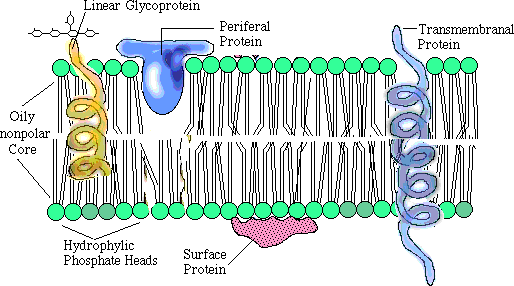
| MadSci Network: Cell Biology |
Hi Addy, The Plasma Membrane (also known as the lipid bilayer, see Figure 1) is a dynamic structure and is not static. It is composed of 2 layers (leaflets) of phospholipids with the hydrophobic tails arranged towards the middle of the bilayer and the polar head groups arranged towards the outside so as to interact with hydrophillic substances such as water. Also important to note is that the 2 layers of phospholipids are asymmetric, which is to say that there are different phospholipids in the inner leaflet than there are in the outer leaflet. Proteins are found in the plasma membrane and are categorized in 3 ways: transmembrane, peripheral and surface proteins. The phospholipids are in constant motion at physiological temperatures as are the proteins, but the motion is lateral throughout each leaflet. The probability of a protein or phospholipid "flipping" to the other leaflet is low because it is energetically unfavorable. As an aside, there are enzymes called flippases which actually do allow phospholipids to "flip" to the other leaflet. The membrane will remain fluid as temperature is decreased until a critical temperature is reached at which time the membrane will crystallize and solidify. This critical temperature depends on the membrane's fatty acid composition. For example, a membrane that contains a large amount of phospholipids with double bonds in their hydrocarbon chains will have a lower crystallization temperature than a membrane which contains phospholipids with fewer or no double bonds. The double bonds create a "kink" in the hydrocarbon tails which prevent the phospholipids from packing together tightly and thus crystallizing.
Try the links in the MadSci Library for more information on Cell Biology.